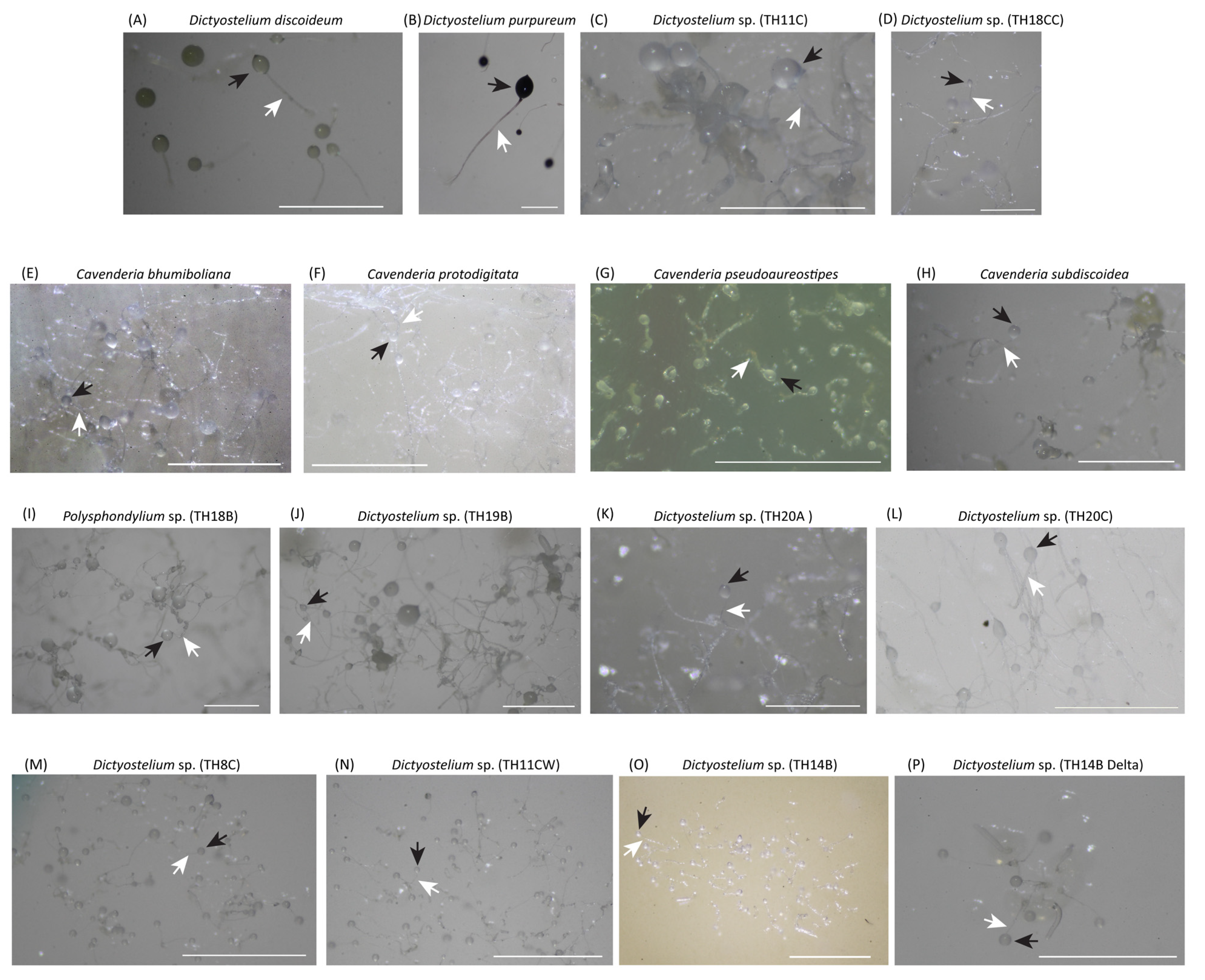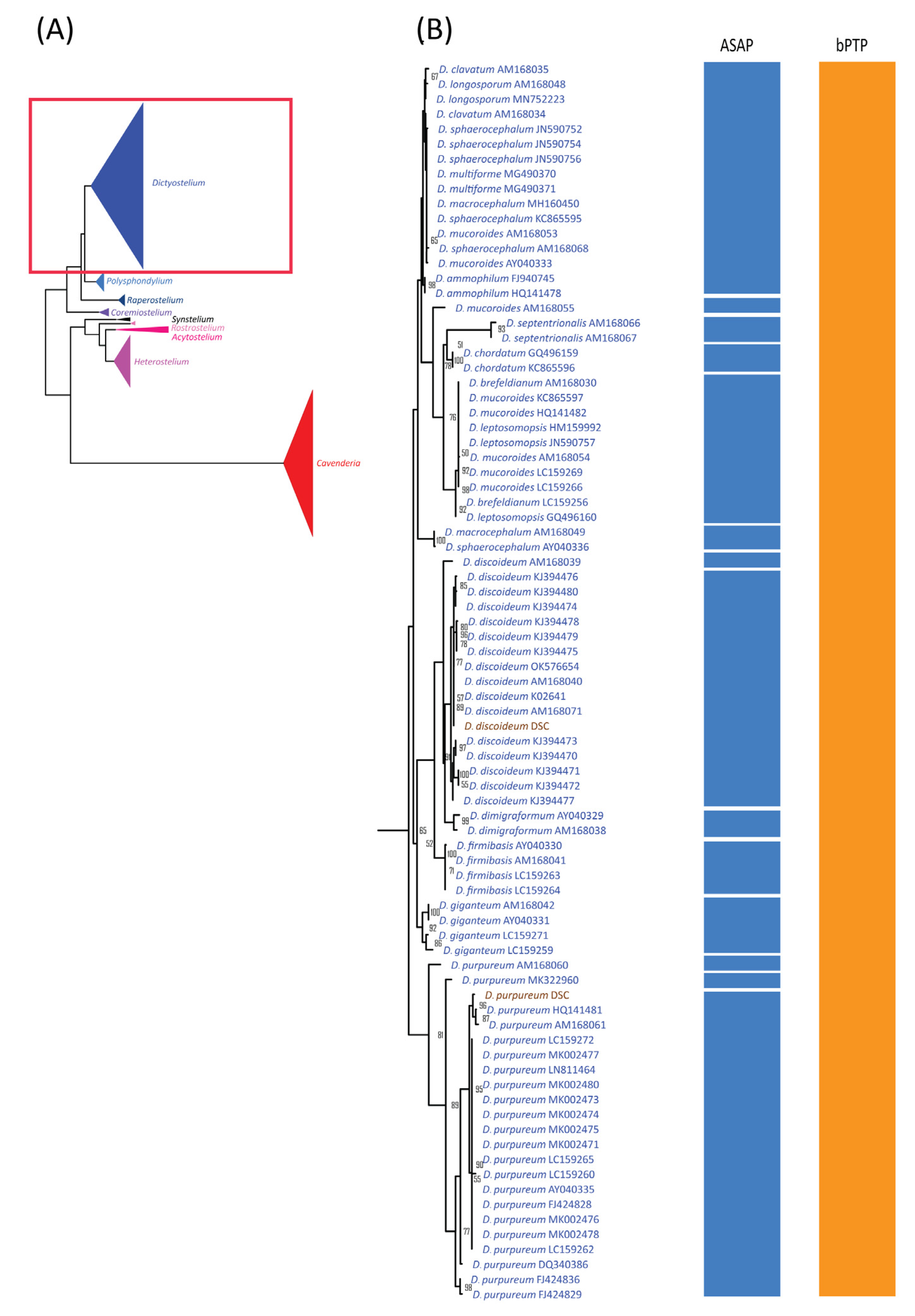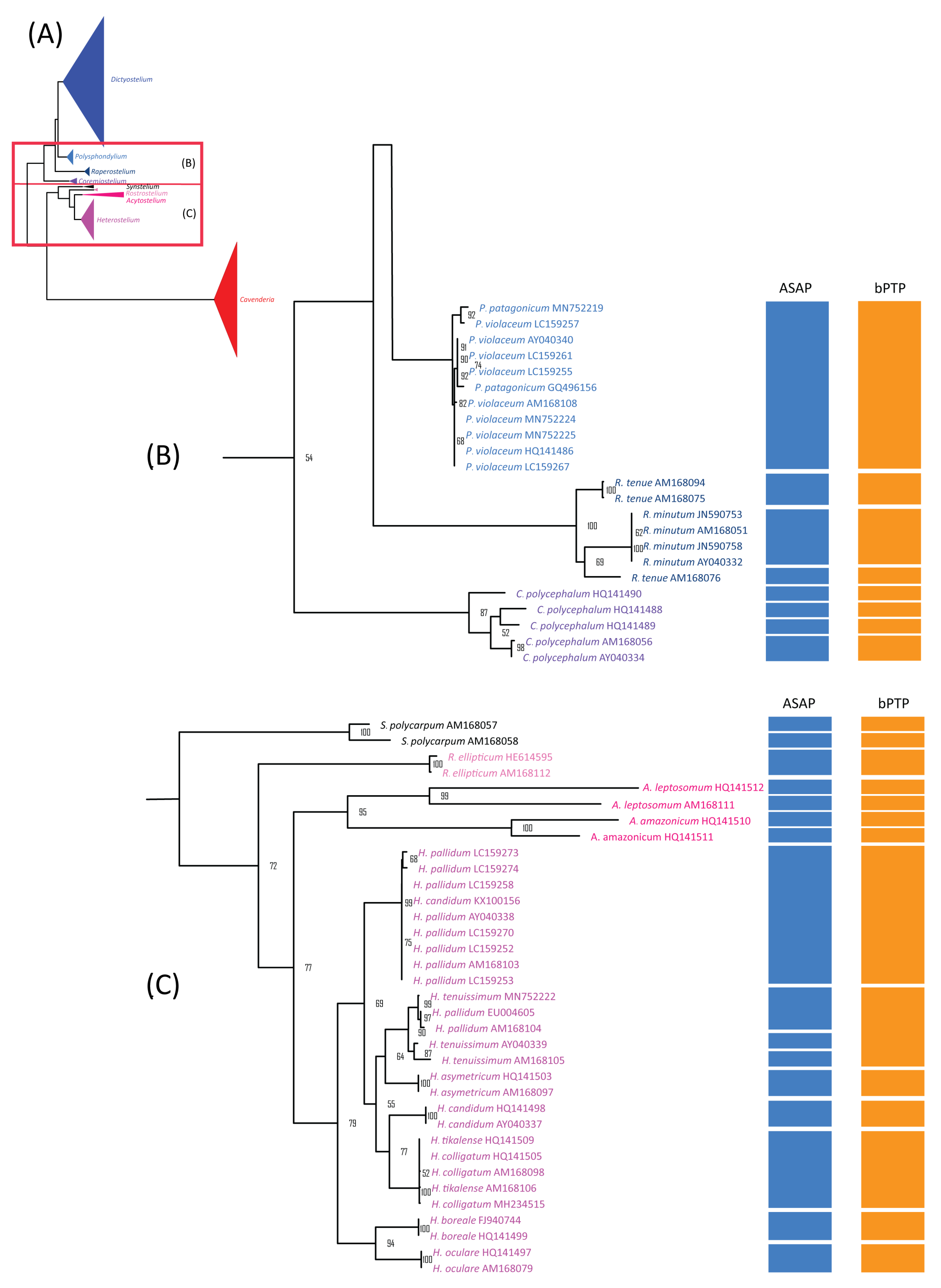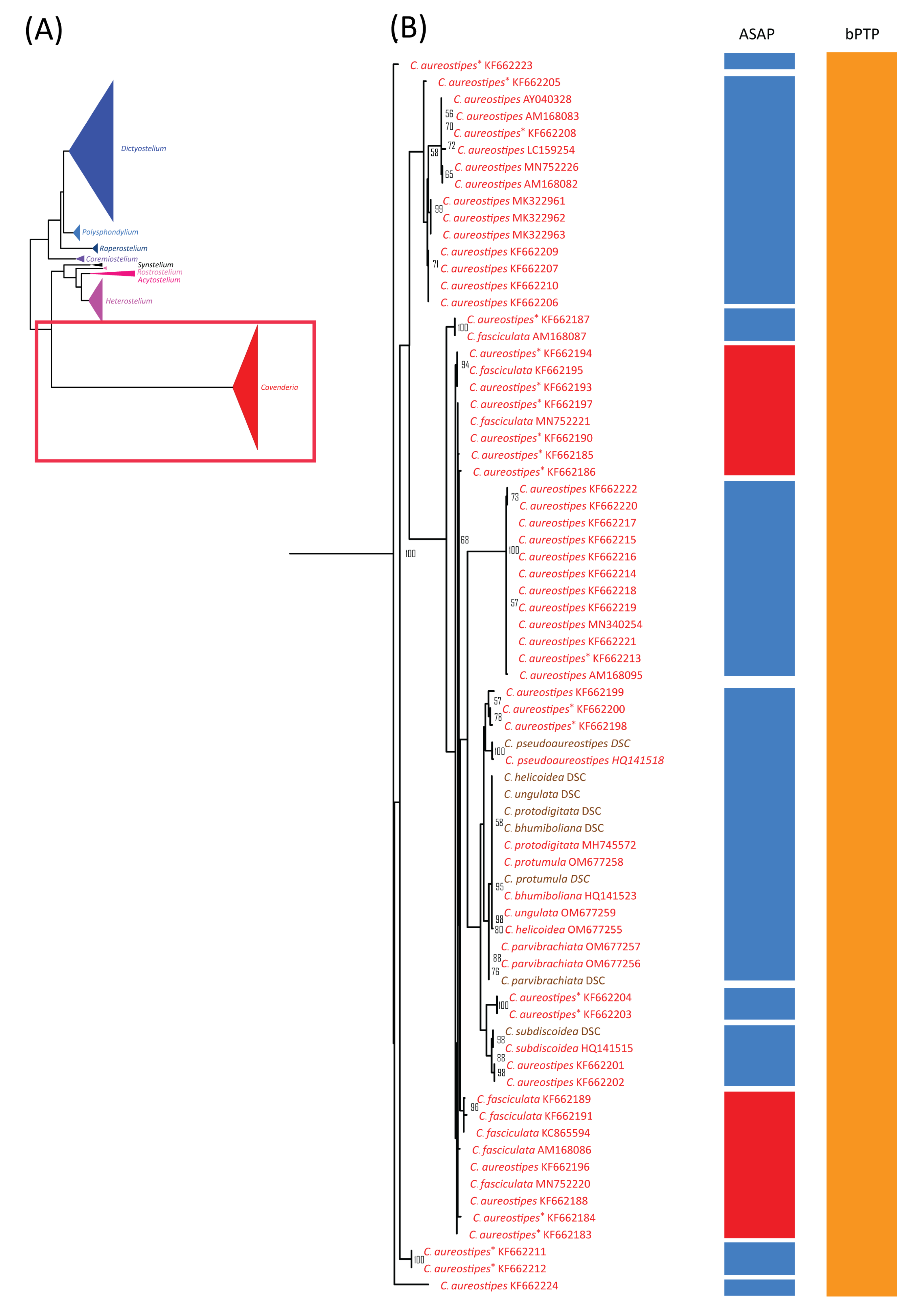Limitations of 18S rDNA Sequence in Species-Level Classification of Dictyostelids
Abstract
1. Introduction
2. Materials and Methods
2.1. Sample Collection and 18S rDNA Amplification
2.2. Sequence Data Collection
2.3. 18S rDNA Sequence Analysis
2.4. Success Rate of Species Delimitation Calculation
3. Results
3.1. Identification of 16 Selected Samples
3.2. Interspecific and Intraspecific Variation Among Selected Samples
3.3. Interspecific and Intraspecific Variation Comparison and Barcoding Gap Analysis
3.4. Species Delimitation Analysis Using ASAP
3.5. Species Delimitation Analysis Using ML Phylogeny
3.6. Species Delimitation Analysis Using bPTP
4. Discussion
5. Conclusions
Supplementary Materials
Author Contributions
Funding
Institutional Review Board Statement
Informed Consent Statement
Data Availability Statement
Acknowledgments
Conflicts of Interest
Abbreviations
| ML | Maximum Likelihood |
| ASAP | Assemble Species by Automatic Partitioning |
| bPTP | Bayesian implementation of the Poisson Tree Process model |
References
- Kin, K.; Schaap, P. Evolution of Multicellular Complexity in The Dictyostelid Social Amoebas. Genes 2021, 12, 487. [Google Scholar] [CrossRef] [PubMed]
- Romeralo, M.; Skiba, A.; Gonzalez-Voyer, A.; Schilde, C.; Lawal, H.; Kedziora, S.; Cavender, J.C.; Glockner, G.; Urushihara, H.; Schaap, P. Analysis of phenotypic evolution in Dictyostelia highlights developmental plasticity as a likely consequence of colonial multicellularity. Proc. Biol. Sci. 2013, 280, 20130976. [Google Scholar] [CrossRef] [PubMed]
- Schaap, P. From environmental sensing to developmental control: Cognitive evolution in dictyostelid social amoebas. Philos. Trans. R. Soc. B 2021, 376, 20190756. [Google Scholar] [CrossRef] [PubMed]
- Sheikh, S. Genomics of Sorocarpic Amoebae; Acta Universitatis Upsaliensis: Uppsala, Sweden, 2017. [Google Scholar]
- Sheikh, S.; Thulin, M.; Cavender, J.C.; Escalante, R.; Kawakami, S.-I.; Lado, C.; Landolt, J.C.; Nanjundiah, V.; Queller, D.C.; Strassmann, J.E.; et al. A New Classification of the Dictyostelids. Protist 2018, 169, 1–28. [Google Scholar] [CrossRef]
- Schaap, P.; Winckler, T.; Nelson, M.; Alvarez-Curto, E.; Elgie, B.; Hagiwara, H.; Cavender, J.; Milano-Curto, A.; Rozen, D.E.; Dingermann, T.; et al. Molecular Phylogeny and Evolution of Morphology in the Social Amoebas. Science 2006, 314, 661–663. [Google Scholar] [CrossRef]
- Romeralo, M.; Escalante, R.; Baldauf, S.L. Evolution and Diversity of Dictyostelid Social Amoebae. Protist 2012, 163, 327–343. [Google Scholar] [CrossRef]
- Cavender, J.C.; Vadell, E.M.; Perrigo, A.L.; Landolt, J.C.; Stephenson, S.L.; Liu, P. Four New Species of Dictyostelids from Soil Systems in Northern Thailand. J. Fungi 2022, 8, 593. [Google Scholar] [CrossRef]
- Liu, P.; Zhang, S.; Zou, Y.; Li, Z.; Stephenson, S.L.; Li, Y. Distribution and ecology of dictyostelids in China. Fungal Biol. Rev. 2020, 34, 170–177. [Google Scholar] [CrossRef]
- Perrigo, A.L.; Vadell, E.M.; Cavender, J.C.; Landolt, J.C.; Liu, P.; Stephenson, S.L. Additional new species suggest high dictyostelid diversity on Madagascar. Mycologia 2020, 112, 1026–1042. [Google Scholar] [CrossRef]
- Rukseree, K.; Wonganun, K.; Palittapongarnpim, P.; Ajawatanawong, P. Phylogenetic diversity of 18S rDNA sequences of dictyostelids from Amnat Charoen Province, Thailand. Mycoshere 2018, 9, 202–214. [Google Scholar] [CrossRef]
- Vadell, E.; Cavender, J.C.; Landolt, J.C.; Perrigo, A.L.; Liu, P.; Stephenson, S.L. Five new species of dictyostelid social amoebae (Amoebozoa) from Thailand. BMC Evol. Biol. 2018, 18, 198. [Google Scholar] [CrossRef] [PubMed]
- Romeralo, M.; Escalante, R.; Sastre, L.; Lado, C. Molecular systematics of dictyostelids: 5.8S ribosomal DNA and internal transcribed spacer region analyses. Eukaryot. Cell 2007, 6, 110–116. [Google Scholar] [CrossRef] [PubMed][Green Version]
- Schilde, C.; Lawal, H.M.; Kin, K.; Shibano-Hayakawa, I.; Inouye, K.; Schaap, P. A well supported multi gene phylogeny of 52 dictyostelia. Mol. Phylogenet. Evol. 2019, 134, 66–73. [Google Scholar] [CrossRef] [PubMed]
- Pasookhush, P.; Usmani, A.; Suwannahong, K.; Palittapongarnpim, P.; Rukseree, K.; Ariyachaokun, K.; Buates, S.; Siripattanapipong, S.; Ajawatanawong, P. Single-Strand Conformation Polymorphism Fingerprint Method for Dictyostelids. Front. Microbiol. 2021, 12, 708685. [Google Scholar] [CrossRef]
- Medlin, L.; Elwood, H.J.; Stickel, S.; Sogin, M.L. The characterization of enzymatically amplified eukaryotic 16S-like rRNA-coding regions. Gene 1988, 71, 491–499. [Google Scholar] [CrossRef]
- Katoh, K.; Standley, D.M. MAFFT Multiple Sequence Alignment Software Version 7: Improvements in Performance and Usability. Mol. Biol. Evol. 2013, 30, 772–780. [Google Scholar] [CrossRef]
- R Core Team. R: A Language and Environment for Statistical Computing; R Foundation for Statistical Computing: Vienna, Austria, 2022. [Google Scholar]
- Camacho, C.; Coulouris, G.; Avagyan, V.; Ma, N.; Papadopoulos, J.; Bealer, K.; Madden, T.L. BLAST+: Architecture and applications. BMC Bioinform. 2009, 10, 421. [Google Scholar] [CrossRef]
- Larsson, A. AliView: A fast and lightweight alignment viewer and editor for large datasets. Bioinformatics 2014, 30, 3276–3278. [Google Scholar] [CrossRef]
- Puillandre, N.; Brouillet, S.; Achaz, G. ASAP: Assemble species by automatic partitioning. Mol. Ecol. Resour. 2021, 21, 609–620. [Google Scholar] [CrossRef]
- Zhang, J.; Kapli, P.; Pavlidis, P.; Stamatakis, A. A general species delimitation method with applications to phylogenetic placements. Bioinformatics 2013, 29, 2869–2876. [Google Scholar] [CrossRef]
- Brown, S.D.; Collins, R.A.; Boyer, S.; Lefort, M.C.; Malumbres-Olarte, J.; Vink, C.J.; Cruickshank, R.H. Spider: An R package for the analysis of species identity and evolution, with particular reference to DNA barcoding. Mol. Ecol. Resour. 2012, 12, 562–565. [Google Scholar] [CrossRef] [PubMed]
- Edler, D.; Klein, J.; Antonelli, A.; Silvestro, D. raxmlGUI 2.0: A graphical interface and toolkit for phylogenetic analyses using RAxML. Methods Ecol. Evol. 2020, 12, 1–5. [Google Scholar] [CrossRef]
- Zhou, Z.; Guo, H.; Han, L.; Chai, J.; Che, X.; Shi, F. Singleton molecular species delimitation based on COI-5P barcode sequences revealed high cryptic/undescribed diversity for Chinese katydids (Orthoptera: Tettigoniidae). BMC Evol. Biol. 2019, 19, 79. [Google Scholar] [CrossRef] [PubMed]
- Rambaut, A. FigTree v1. 3.1. 2009. Available online: http://tree.bio.ed.ac.uk/software/figtree/ (accessed on 5 August 2022).
- Zhang, Z.; Li, M.; Zhang, S.; Qin, Y.; Zhao, J.; Li, Y.; Stephenson, S.L.; Qiu, J.; Liu, P. Diversity of Cellular Slime Molds (Dictyostelids) in the Fanjing Mountain Nature Reserve and Geographical Distribution Comparisons with Other Representative Nature Reserves in Different Climate Zones of China. Microorganisms 2024, 12, 1061. [Google Scholar] [CrossRef]
- Zou, Y.; Hou, J.; Guo, S.; Li, C.; Li, Z.; Stephenson Steven, L.; Pavlov Igor, N.; Liu, P.; Li, Y. Diversity of Dictyostelid Cellular Slime Molds, Including Two Species New to Science, in Forest Soils of Changbai Mountain, China. Microbiol. Spectr. 2022, 10, e0240222. [Google Scholar] [CrossRef]
- Romeralo, M.; Cavender, J.C.; Landolt, J.C.; Stephenson, S.L.; Baldauf, S.L. An expanded phylogeny of social amoebas (Dictyostelia) shows increasing diversity and new morphological patterns. BMC Evol. Biol. 2011, 11, 84. [Google Scholar] [CrossRef]
- Bailly, J.; Fraissinet-Tachet, L.; Verner, M.C.; Debaud, J.C.; Lemaire, M.; Wesolowski-Louvel, M.; Marmeisse, R. Soil eukaryotic functional diversity, a metatranscriptomic approach. ISME J. 2007, 1, 632–642. [Google Scholar] [CrossRef]
- Hadziavdic, K.; Lekang, K.; Lanzen, A.; Jonassen, I.; Thompson, E.M.; Troedsson, C. Characterization of the 18S rRNA gene for designing universal eukaryote specific primers. PLoS ONE 2014, 9, e87624. [Google Scholar] [CrossRef]
- Gdanetz, K.; Benucci, G.M.N.; Vande Pol, N.; Bonito, G. CONSTAX: A tool for improved taxonomic resolution of environmental fungal ITS sequences. BMC Bioinform. 2017, 18, 538. [Google Scholar] [CrossRef]
- Hibbett, D.; Abarenkov, K.; Koljalg, U.; Opik, M.; Chai, B.; Cole, J.; Wang, Q.; Crous, P.; Robert, V.; Helgason, T.; et al. Sequence-based classification and identification of Fungi. Mycologia 2016, 108, 1049–1068. [Google Scholar] [CrossRef]
- Perrigo, A.L.; Romeralo, M.; Baldauf, S.L. The Yellow Slime Mold Is a Red Herring: Large Hidden Diversity in a Single Protist Morphospecies. 2013. Available online: https://www.diva-portal.org/smash/record.jsf?pid=diva2%3A659483&dswid=885 (accessed on 6 January 2025).
- Ahrens, D.; Fujisawa, T.; Krammer, H.J.; Eberle, J.; Fabrizi, S.; Vogler, A.P. Rarity and Incomplete Sampling in DNA-Based Species Delimitation. Syst. Biol. 2016, 65, 478–494. [Google Scholar] [CrossRef]
- Ranasinghe, U.; Eberle, J.; Thormann, J.; Bohacz, C.; Benjamin, S.P.; Ahrens, D. Multiple species delimitation approaches with COI barcodes poorly fit each other and morphospecies—An integrative taxonomy case of Sri Lankan Sericini chafers (Coleoptera: Scarabaeidae). Ecol. Evol. 2022, 12, e8942. [Google Scholar] [CrossRef]






| Sample Code | Previously Defined Species | Depth of Coverage | BLASTN Analysis | Genus Specified Based on Signature Sequence | Source as Stated in Dicty Stock Center | GenBank Accession No. | ||
|---|---|---|---|---|---|---|---|---|
| Species | Accession Number | Percent Identity | ||||||
| Dpur | Dictyostelium purpureum a | 2–115 | Dictyostelium purpureum | AM168061.1 | 99.68% | Dictyostelium | Axenic strain grows in HL5 with 10% fetal bovine serum | PQ834598 |
| Ddis | Dictyostelium discoideum a | 2–109 | Dictyostelium discoideum | AM168071.1 | 100.00% | Dictyostelium | Wild strain obtained from Dennis Welker | PQ834601 |
| TH11C | Dictyostelium sp. a | 1–192 | Dictyostelium mucoroides, Dictyostelium capitatum | HQ141482.1, AM168032.1 | 99.84% 99.84% | Dictyostelium | Doi Inthanon National Park, Chom Thong District, Chiang Mai Province, Thailand | PQ834599 |
| TH18CC | Dictyostelium sp. a | 3–184 | Dictyostelium mucoroides, Dictyostelium capitatum | HQ141482.1, AM168032.1 | 99.84% 99.84% | Dictyostelium | Doi Inthanon National Park, Chom Thong District, Chiang Mai Province, Thailand | PQ834600 |
| TH14B (Delta) | Dictyostelium sp. a | 1–210 | Raperostelium monochasioides | AM168052.1 | 99.83% | Raperostelium | Songkhla Zoo, Mueang Songkhla District, Songkhla Province, Thailand | PQ834597 |
| TH8C | Dictyostelium sp. a | 1–105 | Dictyostelium sp. TH8C | HQ141492.1 | 99.89% | Raperostelium | Mushroom Research Center, Bahn Pa Dheng, Mae Taeng, Chiang Mai Province, Thailand | PQ834596 |
| TH11CW | Dictyostelium sp. a | 1–192 | Dictyostelium sp. TH14B | HQ141491.1 | 99.89% | Raperostelium | Doi Inthanon National Park, Chom Thong District, Chiang Mai Province, Thailand | PQ834594 |
| TH14B | Dictyostelium sp. a | 1–195 | Dictyostelium sp. TH14B | HQ141491.1 | 99.89% | Raperostelium | Doi Inthanon National Park, Chom Thong District, Chiang Mai Province, Thailand | PQ834595 |
| Csub | Cavenderia subdiscoidea a | 2–103 | Dictyostelium sp. TH1A | HQ141515.1 c | 99.95% | Cavenderia | Mushroom Research Center, Bahn Pa Dheng, Mae Taeng, Chiang Mai Province, Thailand | PQ834586 |
| Cpse | Cavenderia pseudoaureostipes a | 1–68 | Dictyostelium sp. TH39A | HQ141518.1 c | 99.98% | Cavenderia | Wat Pong AO (Temple), Mae Chan District, Chiang Rai Province, Thailand | PQ834587 |
| TH18B | Cavenderia ungulata b | 1–188 | Dictyostelium sp. THC11X | HQ141523.1 c | 100.00% | Cavenderia | Doi Inthanon National Park, Chom Thong District, Chiang Mai Province, Thailand | PQ834591 |
| TH19B | Cavenderia helicoidea b | 1–110 | Dictyostelium sp. THC11X | HQ141523.1 c | 100.00% | Cavenderia | Doi Inthanon National Park, Chom Thong District, Chiang Mai Province, Thailand | PQ834592 |
| TH20A | Cavenderia protumula b | 1–111 | Dictyostelium sp. THC11X | HQ141523.1 c | 100.00% | Cavenderia | Doi Inthanon National Park, Chom Thong District, Chiang Mai Province, Thailand | PQ834593 |
| TH20C | Cavenderia parvibrachiata b | 1–39 | Dictyostelium sp. THC11X | HQ141523.1 c | 99.73% | Cavenderia | Doi Inthanon National Park, Chom Thong District, Chiang Mai Province, Thailand | PQ834588 |
| Cbhu | Cavenderia bhumiboliana a | 2–92 | Dictyostelium sp. THC11X | HQ141523.1 c | 100.00% | Cavenderia | Doi Inthanon National Park, Chom Thong District, Chiang Mai Province, Thailand | PQ834590 |
| Cpro | Cavenderia protodigitata a | 2–62 | Dictyostelium sp. THC11X | HQ141523.1 c | 100.00% | Cavenderia | Doi Inthanon National Park, Chom Thong District, Chiang Mai Province, Thailand | PQ834589 |
| Dpur | Ddis | TH11C | TH18CC | TH14B (Delta) | TH8C | TH11CW | TH14B | Csub | Cpse | TH18B | TH19B | TH20A | Cbhu | Cprot | TH20C | |
|---|---|---|---|---|---|---|---|---|---|---|---|---|---|---|---|---|
| Dictyostelium purpureum | NA | 0.047 | 0.042 | 0.042 | 0.115 | 0.114 | 0.105 | 0.105 | 0.254 | 0.254 | 0.253 | 0.253 | 0.253 | 0.253 | 0.253 | 0.251 |
| Dictyostelium discoideum | 0.048 | NA | 0.034 | 0.034 | 0.110 | 0.111 | 0.113 | 0.113 | 0.257 | 0.255 | 0.254 | 0.254 | 0.254 | 0.254 | 0.254 | 0.254 |
| Dictyostelium sp. TH11C | 0.043 | 0.035 | NA | 0.000 | 0.111 | 0.111 | 0.111 | 0.111 | 0.258 | 0.257 | 0.257 | 0.257 | 0.257 | 0.257 | 0.257 | 0.255 |
| Dictyostelium sp. TH18CC | 0.043 | 0.035 | 0.000 | NA | 0.111 | 0.111 | 0.111 | 0.111 | 0.258 | 0.257 | 0.257 | 0.257 | 0.257 | 0.257 | 0.257 | 0.255 |
| Raperostelium sp. TH14B (Delta) | 0.126 | 0.119 | 0.121 | 0.121 | NA | 0.005 | 0.038 | 0.038 | 0.262 | 0.264 | 0.263 | 0.263 | 0.263 | 0.263 | 0.263 | 0.262 |
| Raperostelium sp. TH8C | 0.125 | 0.120 | 0.120 | 0.120 | 0.005 | NA | 0.041 | 0.041 | 0.261 | 0.265 | 0.263 | 0.263 | 0.263 | 0.263 | 0.263 | 0.262 |
| Raperostelium sp. TH11CW | 0.114 | 0.123 | 0.120 | 0.120 | 0.039 | 0.042 | NA | 0.000 | 0.262 | 0.263 | 0.264 | 0.264 | 0.264 | 0.264 | 0.264 | 0.263 |
| Raperostelium sp. TH14B | 0.114 | 0.123 | 0.120 | 0.120 | 0.039 | 0.042 | 0.000 | NA | 0.262 | 0.263 | 0.264 | 0.264 | 0.264 | 0.264 | 0.264 | 0.263 |
| Cavenderia subdiscoidea | 0.313 | 0.318 | 0.320 | 0.320 | 0.325 | 0.324 | 0.325 | 0.325 | NA | 0.009 | 0.006 | 0.006 | 0.006 | 0.006 | 0.006 | 0.007 |
| Cavenderia pseudoaureostipes | 0.313 | 0.316 | 0.318 | 0.318 | 0.328 | 0.330 | 0.327 | 0.327 | 0.009 | NA | 0.006 | 0.006 | 0.006 | 0.006 | 0.006 | 0.006 |
| Cavenderia ungulata | 0.312 | 0.313 | 0.318 | 0.318 | 0.326 | 0.326 | 0.328 | 0.328 | 0.006 | 0.006 | NA | 0.000 | 0.000 | 0.000 | 0.000 | 0.002 |
| Cavenderia helicoidea | 0.312 | 0.313 | 0.318 | 0.318 | 0.326 | 0.326 | 0.328 | 0.328 | 0.006 | 0.006 | 0.000 | NA | 0.000 | 0.000 | 0.000 | 0.002 |
| Cavenderia protumula | 0.312 | 0.313 | 0.318 | 0.318 | 0.326 | 0.326 | 0.328 | 0.328 | 0.006 | 0.006 | 0.000 | 0.000 | NA | 0.000 | 0.000 | 0.002 |
| Cavenderia bhumiboliana | 0.312 | 0.313 | 0.318 | 0.318 | 0.326 | 0.326 | 0.328 | 0.328 | 0.006 | 0.006 | 0.000 | 0.000 | 0.000 | NA | 0.000 | 0.002 |
| Cavenderia protodigitata | 0.312 | 0.313 | 0.318 | 0.318 | 0.326 | 0.326 | 0.328 | 0.328 | 0.006 | 0.006 | 0.000 | 0.000 | 0.000 | 0.000 | NA | 0.002 |
| Cavenderia parvibrachiata | 0.309 | 0.313 | 0.315 | 0.315 | 0.325 | 0.325 | 0.327 | 0.327 | 0.007 | 0.006 | 0.002 | 0.002 | 0.002 | 0.002 | 0.002 | NA |
| Species | # Samples | ASAP Analysis | ML Phylogeny | bPTP Analysis | |||
|---|---|---|---|---|---|---|---|
| Group Type | Group No. | Topology | Support (%) | Group Type | Group No. | ||
| Dictyostelium ammophilum | 2 | MERGE | 6 | MONO | 98 | MERGE | 7 |
| Dictyostelium brefeldianum | 2 | MERGE | 5 | non-MONO | N/A | MERGE | 7 |
| Dictyostelium chordatum | 2 | MONO | 8 | MONO | 100 | MERGE | 7 |
| Dictyostelium clavatum | 2 | MERGE | 6 | non-MONO | N/A | MERGE | 7 |
| Dictyostelium dimigraformum | 2 | MONO | 4 | MONO | 99 | MERGE | 7 |
| Dictyostelium discoideum | 17 | SPLIT | 1, 2 | non-MONO | N/A | MERGE | 7 |
| Dictyostelium firmibasis | 4 | MONO | 3 | MONO | 100 | MERGE | 7 |
| Dictyostelium giganteum | 4 | MONO | 9 | MONO | 92 | MERGE | 7 |
| Dictyostelium leptosomopsis | 3 | MERGE | 5 | non-MONO | N/A | MERGE | 7 |
| Dictyostelium longosporum | 2 | MERGE | 6 | non-MONO | N/A | MERGE | 7 |
| Dictyostelium macrocephalum | 2 | multi-SPLIT | 6, 11 | non-MONO | N/A | MERGE | 7 |
| Dictyostelium mucoroides | 8 | multi-SPLIT | 5–7 | non-MONO | N/A | MERGE | 7 |
| Dictyostelium multiforme | 2 | MERGE | 6 | non-MONO | N/A | MERGE | 7 |
| Dictyostelium purpureum | 23 | SPLIT | 12–14 | MONO | 81 | MERGE | 7 |
| Dictyostelium septentrionalis | 2 | MONO | 10 | MONO | 93 | MERGE | 7 |
| Dictyostelium sphaerocephalum | 6 | multi-SPLIT | 6, 11 | non-MONO | N/A | MERGE | 7 |
| Polysphondylium patagonicum | 2 | MERGE | 15 | non-MONO | N/A | MERGE | 8 |
| Polysphondylium violaceum | 9 | MERGE | 15 | non-MONO | N/A | MERGE | 8 |
| Raperostelium minutum | 4 | MONO | 16 | MONO | 100 | SPLIT | 20, 24, 25 |
| Raperostelium tenue | 3 | SPLIT | 17–18 | non-MONO | N/A | SPLIT | 11, 12 |
| Coremiostelium polycephalum | 5 | SPLIT | 19–22 | MONO | 87 | SPLIT | 13, 21–23 |
| Synstelium polycarpum | 2 | SPLIT | 23–24 | MONO | 100 | SPLIT | 18, 19 |
| Rostrostelium ellipticum | 2 | MONO | 34 | MONO | 100 | MONO | 4 |
| Acytostelium amazonicum | 2 | SPLIT | 35, 36 | MONO | 100 | SPLIT | 5, 6 |
| Acytostelium leptosomum | 2 | SPLIT | 37, 38 | MONO | 99 | SPLIT | 2, 3 |
| Cavenderia aureostipes | 29 | multi-SPLIT | 39–42, 44, 45 | non-MONO | N/A | MERGE | 1 |
| Cavenderia bhumiboliana | 2 | MERGE | 45 | non-MONO | N/A | MERGE | 1 |
| Cavenderia cf. aureostipes | 19 | multi-SPLIT | 39–40, 43, 44–48 | non-MONO | N/A | MERGE | 1 |
| Cavenderia fasciculata | 8 | multi-SPLIT | 44, 48 | non-MONO | N/A | MERGE | 1 |
| Cavenderia helicoidea | 2 | MERGE | 45 | non-MONO | N/A | MERGE | 1 |
| Cavenderia parvibrachiata | 3 | MERGE | 45 | MONO | 88 | MERGE | 1 |
| Cavenderia protodigitata | 2 | MERGE | 45 | non-MONO | N/A | MERGE | 1 |
| Cavenderia protumula | 2 | MERGE | 45 | non-MONO | N/A | MERGE | 1 |
| Cavenderia pseudoaureostipes | 2 | MERGE | 45 | MONO | 100 | MERGE | 1 |
| Cavenderia subdiscoidea | 2 | MERGE | 42 | MONO | 98 | MERGE | 1 |
| Cavenderia ungulata | 2 | MERGE | 45 | non-MONO | N/A | MERGE | 1 |
| Heterostelium asymetricum | 2 | MONO | 29 | MONO | 100 | MONO | 17 |
| Heterostelium boreale | 2 | MONO | 30 | MONO | 100 | SPLIT | 26, 27 |
| Heterostelium candidum | 3 | multi-SPLIT | 25, 32 | non-MONO | N/A | multi-SPLIT | 10, 14 |
| Heterostelium colligatum | 3 | MERGE | 33 | non-MONO | N/A | MERGE | 15 |
| Heterostelium oculare | 2 | MONO | 31 | MONO | 100 | MONO | 9 |
| Heterostelium pallidum | 10 | multi-SPLIT | 25–26 | non-MONO | N/A | multi-SPLIT | 10, 16 |
| Heterostelium tenuissimum | 3 | multi-SPLIT | 26–28 | non-MONO | N/A | MERGE | 16 |
| Heterostelium tikalense | 2 | MERGE | 33 | non-MONO | N/A | MERGE | 15 |
| Success rate (%) | 44 | 22.73 | 43.18 | 6.82 | |||
| Success rate with weight (%) | 214 | 12.15 | 31.31 | 2.80 | |||
Disclaimer/Publisher’s Note: The statements, opinions and data contained in all publications are solely those of the individual author(s) and contributor(s) and not of MDPI and/or the editor(s). MDPI and/or the editor(s) disclaim responsibility for any injury to people or property resulting from any ideas, methods, instructions or products referred to in the content. |
© 2025 by the authors. Licensee MDPI, Basel, Switzerland. This article is an open access article distributed under the terms and conditions of the Creative Commons Attribution (CC BY) license (https://creativecommons.org/licenses/by/4.0/).
Share and Cite
Chittavichai, T.; Sathitnaitham, S.; Utthiya, S.; Prompichai, W.; Prommarit, K.; Vuttipongchaikij, S.; Wonnapinij, P. Limitations of 18S rDNA Sequence in Species-Level Classification of Dictyostelids. Microorganisms 2025, 13, 275. https://doi.org/10.3390/microorganisms13020275
Chittavichai T, Sathitnaitham S, Utthiya S, Prompichai W, Prommarit K, Vuttipongchaikij S, Wonnapinij P. Limitations of 18S rDNA Sequence in Species-Level Classification of Dictyostelids. Microorganisms. 2025; 13(2):275. https://doi.org/10.3390/microorganisms13020275
Chicago/Turabian StyleChittavichai, Thanyaporn, Sukhita Sathitnaitham, Supanut Utthiya, Wanasilp Prompichai, Kamonchat Prommarit, Supachai Vuttipongchaikij, and Passorn Wonnapinij. 2025. "Limitations of 18S rDNA Sequence in Species-Level Classification of Dictyostelids" Microorganisms 13, no. 2: 275. https://doi.org/10.3390/microorganisms13020275
APA StyleChittavichai, T., Sathitnaitham, S., Utthiya, S., Prompichai, W., Prommarit, K., Vuttipongchaikij, S., & Wonnapinij, P. (2025). Limitations of 18S rDNA Sequence in Species-Level Classification of Dictyostelids. Microorganisms, 13(2), 275. https://doi.org/10.3390/microorganisms13020275






